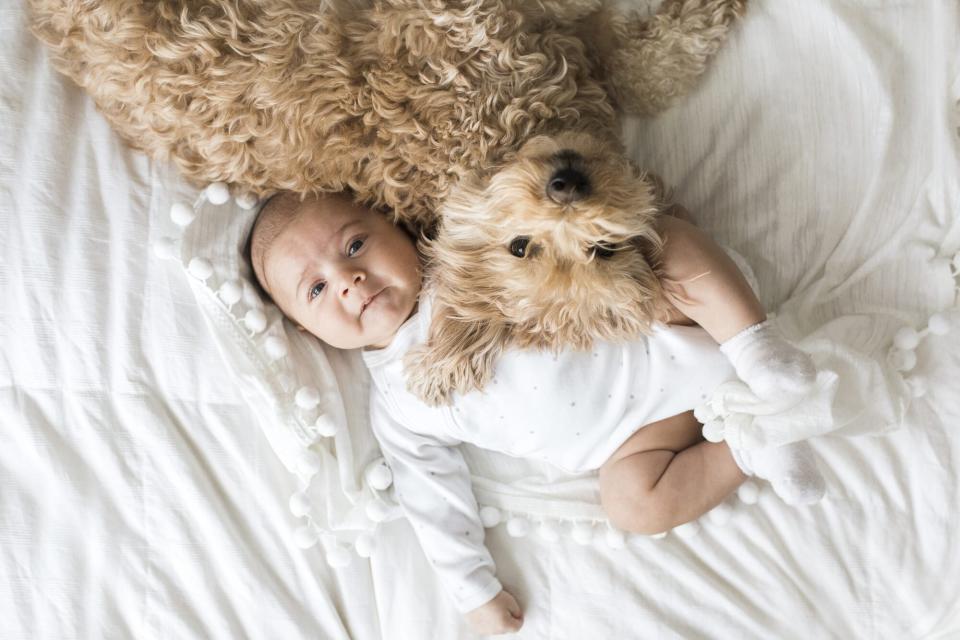How to Introduce Your Dog to a New Baby
Your dog likely knows something's up. Perhaps he's more anxious, alert, or clingy. Besides the change in mom's belly size, things around the house have been strange lately. New contraptions like strollers and bright colored toys have shown up, and mom and dad are adding weird furniture to one of the rooms. Your dog will soon enough likely love the baby you're about to bring home if you plan ahead to ensure a good meeting of your two little ones.
How to Prepare Your Dog for Baby's Arrival
If you have friends with infants, it's a great idea to have them over before your baby arrives so your pup can see a real baby, hear their noises and cries, and learn that having a little one around is par for the course.
As you get new baby gadgets—swings, strollers, and car seats—unpack and set them up alongside your dog so he can see that these contraptions aren't a big deal, even if he doesn't know what they're for yet.
Practice holding a doll and treating it gingerly. Let your dog sniff it and then taking it away to mimic what will happen with a real baby.
When baby finally arrives, Dr. Shadi Ireifej, founder of Vettriage, a telehealth veterinary service, suggests you "take an article of the baby's clothing from the hospital, prior to the baby coming home, and present it to the dog so he can investigate and become accustomed to the baby's scent." You can do this with a baby blanket or onesie the baby wore.
How to Make Introductions
When it's time to head home with a newborn in tow, take some time in making introductions with your canine baby. "When bringing the baby home, set him or her down in a baby carrier, fully supervised, so the dog can sniff and investigate," says Dr. Ireifej. Parents can offer the pup a treat each time he sniffs the baby, behaves, or shows positive interest. Keep treats handy to help your dog learn that baby is okay. You're aiming to make a positive association with baby by using praise and treats.

Getty Images
Continue to let your pup make supervised contact—when you're holding the baby or when the baby is in a swing, carrier, or crib, your pup can sniff softly to see that baby's inside and then be ushered out. Continue to make positive associations like petting your dog and telling him good boy or good girl. Always supervise your dog's interactions with the baby.
Minimize Change in Routine as Much as Possible
Along with baby comes loads of changes in daily routines from when you get up to when you can walk your pup, so help him adjust by keeping feeding times intact. Give him lots of attention when the baby is sleeping. If he's curious about the baby during waking hours, have a cue word to get him out from underfoot, such as "go lie down." If she wants to smell often allow it briefly and then use the cue word. And if pup doesn't like the crying sound, toss a treat or two during crying times to get her over it. Most dogs learn to tune it out shortly.
Babies and Dogs Go Well Together
It's one thing when your baby is confined in a carrier but when she starts crawling, scooting, or walking, your pup will have adjustments to make, too. Dr. Ireifej says that the way babies and toddlers move through the world differs from adults, of course, in terms of noise, movements, balance, and coordination. During each stage, your pup should grow and adjust as your baby grows. Always supervise their interactions even if you think your pup loves the baby. Meanwhile, you'll need to teach the baby how to nicely pet and touch your dog, even before they're mobile, and continue reinforcing it.
If you have to leave the room, make sure the baby and dog are separated by using a playpen or gated area.
Baby and Pup Troubles
If the dog doesn't respond well to the new baby, whether with aggression or fear, you'll need to assess the situation. It may require additional training from a professional or, in the worst of cases, may lead you to finding the dog a new home that better fits his needs.
With training and patience, most mild cases of uncertainty around babies can be overcome. By not forcing your dog to make connections and letting them come around themselves, providing opportunities to walk together with the stroller, and engaging with your dog when the baby is with you, you can begin to expose your dog to the smells, sounds, and ways of baby life. In time, the majority of dogs and babies become fast friends.

